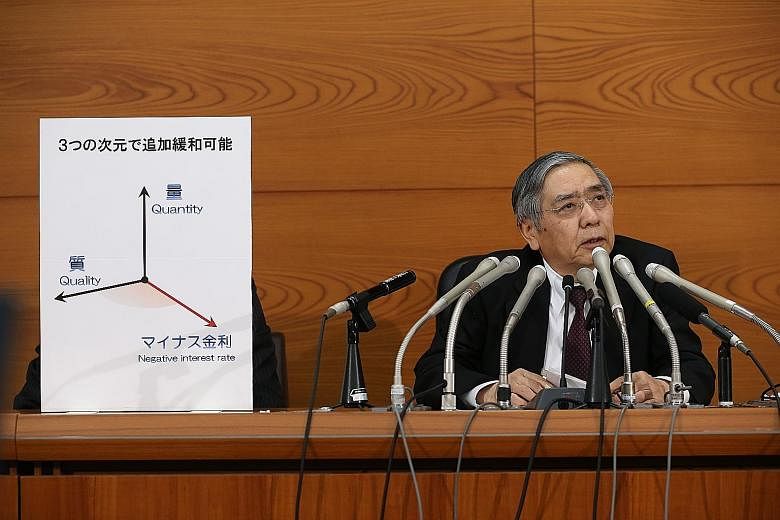TOKYO • The Bank of Japan unexpectedly cut a benchmark interest rate to below zero yesterday, surprising investors with another bold move to revive the economy as volatile markets and slowing global growth threaten its efforts to beat deflation.
Asian shares jumped, the yen tumbled and sovereign bonds rallied after the BOJ said it would charge for a portion of bank reserves parked with the institution, an aggressive policy pioneered by the European Central Bank (ECB).
"What's important is to show people that the BOJ is strongly committed to achieving 2 per cent inflation and that it will do whatever it takes to achieve it," BOJ governor Haruhiko Kuroda told a news conference after the decision.
The yen plunged more than 1 per cent against the euro after the rate on excess reserves held by financial institutions at the BOJ was cut to minus 0.1 per cent. Two-year Japanese government bond yields sank to minus 0.085 per cent.
Mr Kuroda said the central bank will cut the rate further if needed and that he expects to drive yields lower across the bond curve.
"It looks like there will be a competition on negative rates with central banks including the ECB," said Ms Mari Iwashita, chief market economist at SMBC Friend Securities. "The BOJ now has to defend its position in the race, which is likely to persist until uncertainties over emerging economies dissipate."
Mr Kuroda said that negative rates do not replace quantitative easing; they simply add to the BOJ's options. The central bank had pushed back its timeframe for reaching stable 2 per cent inflation to around the six months starting in April next year, the third postponement in less than a year.
"This is positive for equities," said Mr Khiem Do, Hong Kong-based head of multi-asset strategy at Baring Asset Management. "They're trying to weaken the yen to boost exports and get savers to spend."
European and Japanese policy makers have faced extra pressure to boost stimulus after the yen and euro outperformed major peers for most of this month amid demand for havens as tumbling crude oil prices and concerns that China's economy is slowing spurred a more than US$6 trillion (S$8.5 trillion) rout in global stock markets.
The BOJ joined monetary authorities across Europe in betting that central bank rates below zero will cut borrowing costs for companies and households, driving demand for loans as well as encouraging investment in higher-yielding assets.
Critics argue that the policy only perpetuates tit-for-tat currency devaluations, impoverishes commercial lenders and their customers, and encourages fiscal indiscipline by governments enjoying lower borrowing costs.
"I would actually put a more than 50 per cent chance that we will see negative 10-year rates in the next one month," said Mr Takuji Okubo, the Tokyo-based chief economist at Japan Macro Advisors. "I wouldn't be surprised if we were to see an extended depreciation of the yen in the next couple of weeks."
The yen tumbled on concerns that investors looking for yield will take money out of Japan. A weaker currency can help the economy because it supports growth by drawing buyers to the nation's exports.
"They think the ECB policy is successful so they're taking the same policy," said Mr Hideaki Kuriki of Sumitomo Mitsui Trust Asset Management.
REUTERS, BLOOMBERG

